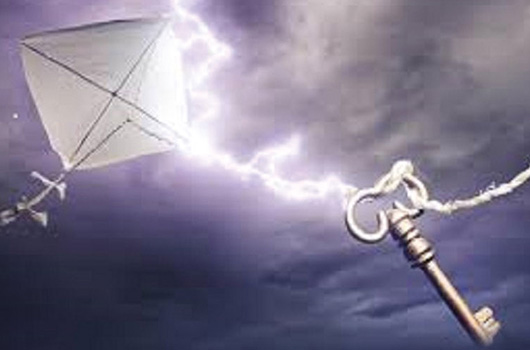History of Static- Electric

The effects of friction have been known for 2700 years. There are lots of examples to trace that friction in daily life. For instance, when you wear a sweater with more nylon, sparks can appear, that shows the movement of the electrical charges. There is another example, while raining, flashes between cloud and earth or cloud and cloud occur. Due to observations and friction, it was found that there were two kinds of electrical charges. If a glass bar rubbed with silk is positioned near another one, they repulse each other. But If you place a plastic bar rubbed with fur near a glass bar, they attract each other. Benjamin Franklin(1706?1790), entitled electrical charges occured on the plastic bar as (-) negative and on the glass bar as (+) positive. Ben Franklin's lightning rod was an important electrical invention.
Lightening Rod
The simple construction of this device has changed little over the last 250 years, and it is still in use worldwide. The construction, however, may have certain nationally conditioned variations. For instance, until the 1970s in France, all lightning rods on public buildings, such as post offices and police stations, had tips covered with radium (226Ra). The idea was that the increased ionization around the tip would increase the neutralizing current to the base of a thundercloud. Although this was correct?at least in theory the rods also produced a little extra radon (222Rn). Because the half-life of radium is about 1600 years, we must hope they had (and still have) a good system for disposing of old lightning rods..
But, with the notable exception of the lightning rod, it wasn'tuntil the beginning of the twentieth century. In 1906, Frederick Cottrell invented the electrofilter or electrostatic precipitator (see Figure 2).That was the first industrial application of electrostatics. The industrial revolution had started to put its black fingerprints on the environment, and the greatest polluters were the smelters and cement mills. The electrofilter was a genuine breakthrough because it trapped ash from coal-burning power plants. It is difficult to imagine what our pollution levels would be like today without this, in principle, very simple but ingenious electrostatic invention.
Electrofilter
The precipitator was only the beginning. Soon after, methods were discovered for separating mixtures of widely different types of particles, followed shortly by methods for electrostatic spray painting and for producing dry coatings for the manufacture of grit cloth and sandpaper. All of these inventions were, in principle, very simple. That was not the case, however, with the work of Chester Carlson. With a degree in law and physics, Carlson worked in a patent office and, therefore, understood the need for copies of patent papers. So, he decided to invent a better copier. After years of honing the experiments, however, the end result was the Xerox process, which has had a great impact on society. Still, all of these processes were known as electrostatics.
In the 1930s, explosions in grain silos were reported at a rate of approximately one per week in the midwestern United States. With this and with increasing explosions in hospital operating rooms and in chemical and pharmaceutical laboratories, people called the cause of these explosions static electricity.
Ignition of explusive vapors
It was quite natural to suspect that an electrostatic discharge was the igniting source in such explosions. But in the 1950s and 1960s, a "new" type of explosion started to appear. Several serious accidents happened when oil tanks were being cleaned with a high-pressure water jet. Although an explosive vapor-air mixture might have originated from the hydrocarbon residue, the ignition source was still unknown. But the cause seemed to be awater slug moving in an inhomogeneous field.
Already in the 1930s, static electricity was a nuisance in the printing industry as well as in the textile industry. Lengths of paper would stick together, and fibers would filter and be hard to control during spinning and weaving. Static electricity made the car radio crackle or caused a minor shock when you handed your nickel to the toll collector. It was these two problems more or less that led to the development in the 1930s of carbon-black-loaded conductive rubber.
With the development in the 1940s and 1950s of all kinds of polymeric materials?such as nylon, orlon, and Teflon?static electricity became a household word. People identified static electricity as the source for why clothing stuck to your body or the reason you got a nasty shock when you touched a water tap. And it was static electricity that made TV screens and monitors dirty. And, according to folklore, static electricity was blamed for headaches and for ruining the "balance between the good negative and the evil positive ions" in the atmosphere.
In the 1960s, static electricity spread into a whole new area: the world of electronics. Some people consider the appearance of the metal oxide semiconductor field-effect transistors (MOSFETs) as the start of this period. That is probably an oversimplification. Static electricity had definitely made itself felt in electronics before the MOSFET, but it was little known. Electrostatics, not to mention static electricity, was not really something that fit into the sophisticated electronics world.
Human-Body-Model event
However, when the output of sensitive components showed a high percentage of failures and, even worse, when complicated circuits had latent breakdowns, some electronic physicists considered relations between charges in the nC-range and field strengths high enough to cause breakdown, such as that illustrated in the diagram for a human-body-model event
For many people in the electronics industry, however, the field of static electricity was completely new. "They Think They Invented It," and since they considered it a new field, they needed a new name, and thus electrostatic discharge (ESD) was coined.
